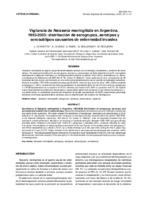Please use this identifier to cite or link to this item:
http://sgc.anlis.gob.ar/handle/123456789/138| Title: | Vigilancia de Neisseria meningitidis en Argentina, 1993-2005: distribución de serogrupos, serotipos y serosubtipos causantes de enfermedad invasiva | Other Titles: | Surveillance of Neisseria meningitidis in Argentina, 1993-2005: Distribution of serogroups, serotypes and serosubtypes isolated from invasive disease | Authors: | Chiavetta, Laura Chávez, E. Ruzic, Adriana Mollerach, M. Regueira, Mabel |
Keywords: | Neisseria meningitidis;Argentina | Issue Date: | 2007 | Journal: | Revista Argentina de microbiologia | Abstract: | Neisseria meningitidis es agente causal de enfermedades severas como meningitis, bacteriemia y síndrome de shock séptico. Se presenta la distribución en serogrupos, serotipos y serosubtipos de 2244 aislamientos de N. meningitidis obtenidos de cuadros de meningitis y/o meningococcemia durante el período 1993-2005 y analizados en el Laboratorio Nacional de Referencia del INEI-ANLIS “Dr. Carlos G. Malbrán”. Estos aislamientos eran provenientes de 33 hospitales de todo el país, conformados en una red nacional de laboratorios para el estudio de meningitis bacteriana. Durante el período 1993-1995 prevaleció el serogrupo B (66%), mientras que entre los años 1995 y 2001 prevaleció el serogrupo C (65%); a partir de esta fecha se restableció la prevalencia de B. En los últimos 5 años los serogrupos Y y W135 representaron en su conjunto el 15,6%, mientras que hasta el año 2000 no superaron el 4,7%. Se registró mayor diversidad en la distribución de serotipos y serosubtipos dentro del serogrupo B que dentro del serogrupo C. Los aislamientos no subtipables durante todo el período de estudio representaron el 52,8%; este elevado porcentaje evidencia la limitada capacidad de la serología para la determinación de subtipos de meningococo. Neisseria meningitidis is an important cause of meningitis, bacteremia and septic shock syndrome. We herein present the distribution of serogroups, serotypes and serosubtypes of 2244 isolates of N. meningitidis from patients with meningitis or meningococcemia, received within the period 1993-2005, in the National Reference Laboratory, INEI-ANLIS “Dr. Carlos G. Malbrán”, from 33 Argentine hospitals that are included in a National Network devoted to for the study of bacterial meningitis. Between 1993-1995, serogroup B was prevalent (66%) whereas in the period from 1995-2001, serogroup C prevailed (65%). However, following but after that period, the prevalence of serogroup B was recovered. In the last 5 years of the studied period, the serogroups Y and W135 represented as a whole a 15.6% as a whole whereas up to the year 2000 during the first 6 years they accounted for it was of 4.7%. Higher diversity in the distribution of serotypes and serosubtypes was observed within serogroup B. The nonsubtypable isolates throughout the period of study represented the 52.8%, this high percentage demonstrates the limited capacity of the serotyping for the determination of meningococcal/meningococcus subtypes. of meningococco. |
Description: | Fil: Chiávetta, L. ANLIS Dr.C.G.Malbrán. Instituto Nacional de Enfermedades Infecciosas; Argentina. Fil: Chávez, E. ANLIS Dr.C.G.Malbrán. Instituto Nacional de Enfermedades Infecciosas; Argentina. Fil: Ruzic, A. ANLIS Dr.C.G.Malbrán. Instituto Nacional de Enfermedades Infecciosas; Argentina. Fil: Mollerach, M. Universidad de Buenos Aires. Facultad de Farmacia y Bioquímica; Argentina. Fil: Regueira, M. ANLIS Dr.C.G.Malbrán. Instituto Nacional de Enfermedades Infecciosas; Argentina. |
URI: | http://www.scielo.org.ar/pdf/ram/v39n1/v39n1a07.pdf http://sgc.anlis.gob.ar/handle/123456789/138 |
ISSN: | 0325-7541 | Rights: | info:eu-repo/semantics/openAccess Creative Commons Attribution 4.0 International License |
| Appears in Collections: | snrd Publicaciones INEI |
Files in This Item:
| File | Description | Size | Format | |
|---|---|---|---|---|
| RevistaArgentinadeMicrobiología,2007,39(1),21–27..pdf | 53.75 kB | Adobe PDF |  View/Open |
Page view(s)
183
checked on Jan 7, 2026
Download(s)
49
checked on Jan 7, 2026
Google ScholarTM
Check
This item is licensed under a Creative Commons License


